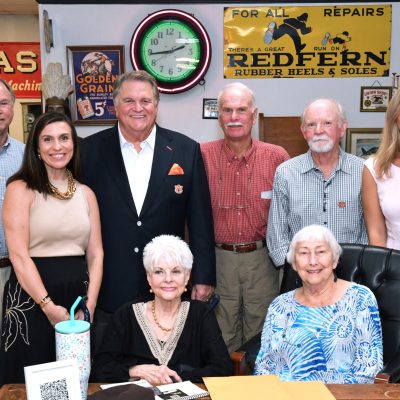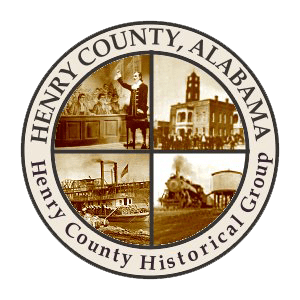
Headland was officially established on October 10, 1871, when the U. S. Post Office was opened at “Headland, Alabama”. However, Headland was settled before this time. A settlement was already at the location where the Eufaula-Marianna mail route crossed the Columbia-Newton Road just after the Civil War. The “Church of Christ at Bethlehem” was formed here circa July 1, 1868. This church was the start of the First Baptist Church of Headland. This church was located about where the Quince Hollon house later stood on Cleveland Street. Also, another settlement had been started about a mile east of present Headland by a Johnson family and was called “Johnsontown”. The family of Mr. Thomas F. Espy later lived on this property. He was the grandfather of Major W. Espy. Also, the Piney Grove Primitive Baptist Church had been organized in 1849 northwest of present Headland.
Headland was somewhat later being settled due to the belief by early settlers that the pine lands were not productive and because so many standing ponds and swampy areas dotted the landscape. Therefore, the area was deemed unhealthy. The lands of Sections 33 and 4 of T-5, R-27, where Headland now stands, wasn’t homesteaded or claimed until after the Civil War. Mr. William Whitehead, on October 10, 1869, sold Mr. J. J. Head 80 acres in Section 33 and 80 acres in Section 4 where Headland is located. Apparently, Mr. Whitehead did not have a clear title to this land, for on January 11, 1870, Mr. J. J. Head filed a claim with the land office and received a homestead grant for this same 160 acres. Mr. Head had settled in Henry County, Alabama, circa 1866. As more settlers moved into the area, more people referred to the settlement near the cross roads as “Head’s Land” simply because Mr. J. J. Head owned lands there.
TID-BITS
- After the post office had opened in 1871 and the little settlement now known as Headland, more families began migrating into the area. A few businesses started to pop up around Mr. Head’s public square. Several young doctors were attracted to the newly formed village: Dr. Wyatt S. Oates, Dr. Charles F. Sporman, Dr. John E. Price, Dr. W. P. Walden and W. P. Hardwick. They all started promoting the village. Among some of Headland’s early settlers were John C. Hardwick, Jazh Bass, J. A. Hollon, A. S. Hollon and Irwin M. Stringer.
- My 1880, Mr. J. J. Head was calling himself’s a doctor and opened an office in Headland and was still in real estate. He had left the Village of Headland by 1884, having sold the town in 1879. He moved to Tampa, Florida, and didn’t take part in the incorporation of Headland.
- In 1884, a group of Village citizens banded together, with the leadership of Dr. Wyatt S. Oates, and decided to file a petition to incorporate and decided the name of the town would continue to be Headland, after J. J. Head.
- According to the law, 30 petitioners were needed to sign the petition to incorporate. Twenty-six white men were gathered and four colored me were asked to sign in order to have the required 30 petitioners.
- The twenty-six white men who signed the incorporation petition were: Dr. J. E. Price, King D. Jones, Dr. Charles F. Sporman, J. T. Hartzon, W. T. Buntin, John S. King, M. J. Walding, John C. Hardwick, George W. Nowell, Dr. Wyatt S. Oates, J. W. Stucky, B. F. Bracewell, T. J. Pennington, C.P. Cotter, J. H. Cook, I. McClung, T. J. Baldwin, J. E. Grice, B. W. Herring, W. H. Herring, Dr. William P. Hardwick, J. T. Taylor, J. A. Hollon, James M. Alston, William Sanders, and J. I. Reeves.
- The four colored men who signed the incorporation petition were: William Clark, Robert Lunsford, George Dick and C. Jones.
- The petition stated that Headland’s size would extend one mile in all four directions from the center of the public square, thus being two miles square in shape.
- On August 12, 1884, an “Order of an Election” was signed by Judge Dan Gordon calling for an election to be held for the incorporation of Headland.
- This election was held at the Price-Sporman drug store on August 30, 1884, from 10:00 a.m. to 5:00 p.m., all males 21 years old and living for three months in the village were qualified to vote in election. Dr. C. F. Sporman, J. T. Hartzog, and B. M. Herring were named election inspectors to conduct the election according to the law. A notice of an “incorporation Election” was to be posted at all public places in the Village for 15 days. The voters casting ballots in favor of incorporation were to write “Corporation” on the ballot. Thos opposing incorporation were to write “No Corporation” on the ballot. The inspectors of the election had to take an oath to conduct the election fairly. They must certify the election results to Probate Judge Daniel Gordon in 5 days.
- On August 30, 1884, the election was conducted and the election returns were reported to Judge Gordon. The results were For “Corporation” – 36. Against “No Corporation” – 0. This return was signed by Dr. C. F. Sporman, J. T. Hartzog and Dr. William P. Hardwick. Judge Dan Gordon signed the “Order of Incorporation”. Headland is now a legal incorporated town as of August 30, 1884.
- On September 2, 1884, Judge Dan Gordon issued a notice to Henry County Sheriff A. B. Skipper to order an election be held for electing the town of Headland’s first city officials. An order was issued listing Dr. C. F. Sporman, D. J. E. Price and John C. Hardwick to one again hold an election at the Price-Sporman drug store from 8:00 a.m. to 5:00 p.m. to elect officials and post a “Notice of Election” for 5 days before the election.
- On September 7, 1884, the election was conducted to elect the first “Official” officers for the town of Headland. Elected were: Dr. Wyatt Steven Oates – Mayor, Councilmen: J. M. Stuckey, J. C. Hardwick, B. M. Herring, J. S. Reeves and Dr. C. F. Sporman. The town of Headland was now in business and was authorized to conduct business as a town under the laws of the State of Alabama, and has been doing so ever since.
- No women voted in the election to incorporate Headland in 1884. Women were not allowed to vote at that time. Only white or black men had the right to vote. But times have changed. Mrs. Sara Ruth Walden Holman became the first woman elected to the Headland City Council in 1984 – 100 years after Headland was incorporated. She also became the first woman elected Mayor in 1992.
- After being elected the first Mayor in late 1884, Dr. W. S. Oates started “cleaning up” and organizing the town. The first Town Marshall was soon hired – Mr. R. A. McClung – and law and order was now in town. Headland was now called the “Queen City” of the Wiregrass.



